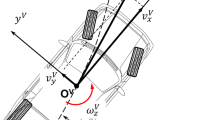Abstract
This paper presents the ground-work of implementing the multibody dynamics codes to analyzing nonlinear coupled oscillators. The recent developments of the multibody dynamics have resulted in several computer codes that can handle large systems of differential and algebraic equations (DAE). However, these codes cannot be used in their current format without appropriate modifications. According to multibody dynamics theory, the differential equations of motion are linear in the acceleration, and the constraints are appended into the equations of motion through Lagrange's multipliers. This formulation should be able to predict the nonlinear phenomena established by the nonlinear vibration theory. This can be achieved only if the constraint algebraic equations are modified to include all the system kinematic nonlinearities. This modification is accomplished by considering secondary nonlinear displacements which are ignored in all current codes. The resulting set of DAE are solved by the Gear stiff integrator. The study also introduced the concept of constrained flexibility and uses an instantaneous energy checking function to improve integration accuracy in the numerical scheme. The general energy balance is a single scalar equation containing all the energy component contributions. The DAE solution is then compared with the solution predicted by the nonlinear vibration theory. It also establishes new foundation for the use of multibody dynamics codes in nonlinear vibration problems. It is found that the simulation CPU time is much longer than the simulation of the original equations of the system.
Similar content being viewed by others
References
Whittaker, E. T.,Treatise on the Analytical Dynamics of Particles and Rigid Bodies, 4th Edition, Dover Publications, New York, 1944.
Paul, B. ‘Analytical dynamics of mechanisms—A computer oriented overview’,Mechanisms and Machine Theory 10, 1975, 481–507.
Nikravesh, P.,Computer-Aided Analysis of Mechanical Systems, Prentice Hall, Englewood Cliffs, New Jersey, 1988.
Cipra, R. J., ‘On the dynamic simulation of large nonlinear mechanical systems’, Ph.D. Dissertation, University of Wisconsin-Madison, Madison, Wisconsin, 1978.
Hurty, W. C., ‘Dynamic analysis of structural systems using component modes’,AIAA Journal 3, 1965, 678–685.
Shabana, A. A. and Wehage, R. A., ‘Variable degree of freedom component mode analysis of inertia-variant flexible mechanical system’,ASME Journal of Mechanisms, Transmission, and Automation in Design 105, 1983, 371–378.
Shabana, A. A. and Wehage, R. A., ‘A coordinate reduction technique for transient Analysis of spatial substructures with large angular rotations’,Journal of Structural Mechanics 11, 1983, 401–431.
Shabana, A. A. and Wehage, R. A., ‘Spatial transient analysis of inertia-variant flexible systems’,ASME Journal of Mechanisms, Transmissions, and Automation in Design 106, 1984, 172–178.
Khulief, Y. A. and Shabana, A. A., ‘Impact response of multibody systems with consistent and lumped masses’,Journal of Sound and Vibration 104, 1986, 197–207.
Nayfeh, A. H. and Mook, D. T.,Nonlinear Oscillations, Wiley-Interscience, New York, 1979.
Schmidt, G. and Tondl, A.,Nonlinear Vibrations, Cambridge University Press, Cambridge, England, 1986.
Szemplinska-Stupnicka, W.,The Behavior of Nonlinear Vibration Systems, Vols. I&II. Kluwer Academic Publishers, Dordrecht, The Netherlands, 1990.
Hsu, C. S.,Cell-to-Cell Mapping: A Method of Global Analysis for Nonlinear Systems, Springer-Verlag, New York, 1987.
Thomson, J. M. T. and Stewart, H. B.,Nonlinear Dynamics and Chaos, John Wiley & Sons, Chichester, England, 1986.
Moon, F. C.,Chaotic Vibrations, John Wiley & Sons, New York, 1987.
Struble, R. A.,Nonlinear Differential Equations, McGraw-Hill, New York, 1962.
Haxton, R. S. and Barr, A. D. S., ‘The autoparametric vibration absorber’,ASME Journal of Engineering for Industry 94, 1972, 119–125.
Gear, C. W., ‘Simultaneous numerical solution of differential-algebraic equations’,IEEE Transactions on Circuit Theory CT-18, 1971, 89–95.
Orlandea, N., ‘Node analogous, sparsity-oriented methods for simulation of mechanical dynamic systems’, Ph.D. Thesis, University of Michigan, Ann Arbor, Michigan, 1973.
Reinhall, P. G., Caughey, T. K., and Storti, D. W., ‘Order and chaos in discrete Duffing oscillator: implications on numerical integration’,ASME Journal of Applied Mechanics 56, 1989, 162–167.
Kovacs, A. P., ‘Kane and Levinson's method for testing numerical integration of mechanical equations of motion: ADAMS examples and formulations’, Proceedings of the International ADAMS Users' Conference, Ann Arbor, Michigan, September 26–27, 1989.
Author information
Authors and Affiliations
Rights and permissions
About this article
Cite this article
Kovacs, A.P., Ibrahim, R.A. Relationship between multibody dynamics computation and nonlinear vibration theory. Nonlinear Dyn 4, 635–653 (1993). https://doi.org/10.1007/BF00162235
Received:
Accepted:
Issue Date:
DOI: https://doi.org/10.1007/BF00162235




